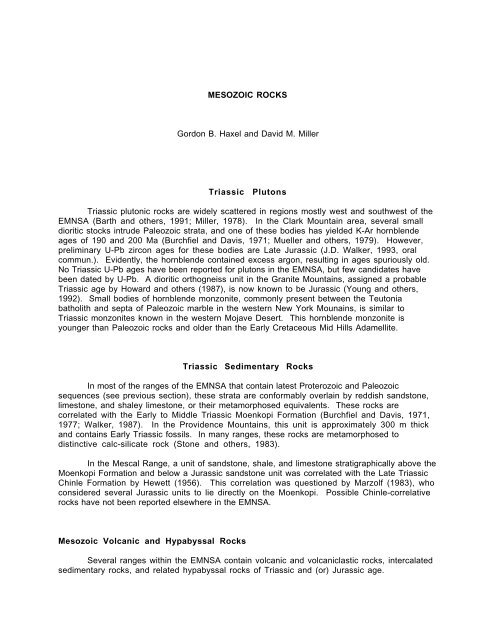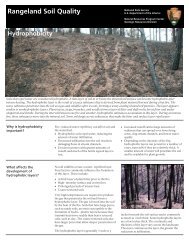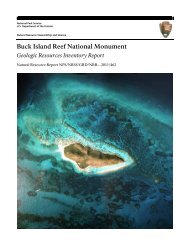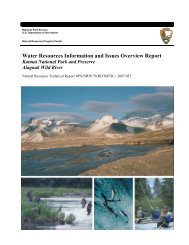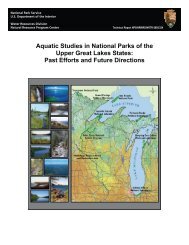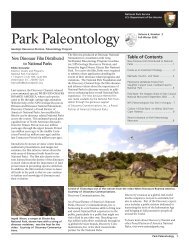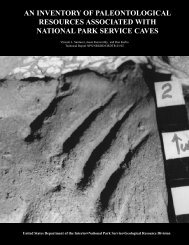MESOZOIC ROCKS Gordon B. Haxel and David M. Miller Triassic ...
MESOZOIC ROCKS Gordon B. Haxel and David M. Miller Triassic ...
MESOZOIC ROCKS Gordon B. Haxel and David M. Miller Triassic ...
Create successful ePaper yourself
Turn your PDF publications into a flip-book with our unique Google optimized e-Paper software.
<strong>MESOZOIC</strong> <strong>ROCKS</strong><br />
<strong>Gordon</strong> B. <strong>Haxel</strong> <strong>and</strong> <strong>David</strong> M. <strong>Miller</strong><br />
<strong>Triassic</strong> Plutons<br />
<strong>Triassic</strong> plutonic rocks are widely scattered in regions mostly west <strong>and</strong> southwest of the<br />
EMNSA (Barth <strong>and</strong> others, 1991; <strong>Miller</strong>, 1978). In the Clark Mountain area, several small<br />
dioritic stocks intrude Paleozoic strata, <strong>and</strong> one of these bodies has yielded K-Ar hornblende<br />
ages of 190 <strong>and</strong> 200 Ma (Burchfiel <strong>and</strong> Davis, 1971; Mueller <strong>and</strong> others, 1979). However,<br />
preliminary U-Pb zircon ages for these bodies are Late Jurassic (J.D. Walker, 1993, oral<br />
commun.). Evidently, the hornblende contained excess argon, resulting in ages spuriously old.<br />
No <strong>Triassic</strong> U-Pb ages have been reported for plutons in the EMNSA, but few c<strong>and</strong>idates have<br />
been dated by U-Pb. A dioritic orthogneiss unit in the Granite Mountains, assigned a probable<br />
<strong>Triassic</strong> age by Howard <strong>and</strong> others (1987), is now known to be Jurassic (Young <strong>and</strong> others,<br />
1992). Small bodies of hornblende monzonite, commonly present between the Teutonia<br />
batholith <strong>and</strong> septa of Paleozoic marble in the western New York Mounains, is similar to<br />
<strong>Triassic</strong> monzonites known in the western Mojave Desert. This hornblende monzonite is<br />
younger than Paleozoic rocks <strong>and</strong> older than the Early Cretaceous Mid Hills Adamellite.<br />
<strong>Triassic</strong> Sedimentary Rocks<br />
In most of the ranges of the EMNSA that contain latest Proterozoic <strong>and</strong> Paleozoic<br />
sequences (see previous section), these strata are conformably overlain by reddish s<strong>and</strong>stone,<br />
limestone, <strong>and</strong> shaley limestone, or their metamorphosed equivalents. These rocks are<br />
correlated with the Early to Middle <strong>Triassic</strong> Moenkopi Formation (Burchfiel <strong>and</strong> Davis, 1971,<br />
1977; Walker, 1987). In the Providence Mountains, this unit is approximately 300 m thick<br />
<strong>and</strong> contains Early <strong>Triassic</strong> fossils. In many ranges, these rocks are metamorphosed to<br />
distinctive calc-silicate rock (Stone <strong>and</strong> others, 1983).<br />
In the Mescal Range, a unit of s<strong>and</strong>stone, shale, <strong>and</strong> limestone stratigraphically above the<br />
Moenkopi Formation <strong>and</strong> below a Jurassic s<strong>and</strong>stone unit was correlated with the Late <strong>Triassic</strong><br />
Chinle Formation by Hewett (1956). This correlation was questioned by Marzolf (1983), who<br />
considered several Jurassic units to lie directly on the Moenkopi. Possible Chinle-correlative<br />
rocks have not been reported elsewhere in the EMNSA.<br />
Mesozoic Volcanic <strong>and</strong> Hypabyssal Rocks<br />
Several ranges within the EMNSA contain volcanic <strong>and</strong> volcaniclastic rocks, intercalated<br />
sedimentary rocks, <strong>and</strong> related hypabyssal rocks of <strong>Triassic</strong> <strong>and</strong> (or) Jurassic age.
Stratigraphic sequences, in varying degrees of preservation, are exposed in four areas: the<br />
Mescal Range, the Old Dad Mountain-Cow Hole Mountains-Soda Mountains area, the New York<br />
Mountains, <strong>and</strong> the Providence Mountains. In a few other areas, metamorphosed or<br />
hydrothermally altered <strong>Triassic</strong> <strong>and</strong> (or) Jurassic volcanic, hypabyssal, <strong>and</strong> sedimentary rocks<br />
are present as small pendants in Jurassic or Cretaceous plutons, or as slivers in fault zones.<br />
Among these small relicts, Jurassic rocks are probably more common than <strong>Triassic</strong> rocks.<br />
Owing to common metamorphism or alteration, <strong>and</strong> to lack of study, little is known about the<br />
petrology <strong>and</strong> geochemistry of <strong>Triassic</strong> <strong>and</strong> Jurassic volcanic rocks in the EMNSA.<br />
A sequence of diverse volcanic <strong>and</strong> sedimentary rocks, more than 3 km thick, in Old Dad<br />
Mountain <strong>and</strong> the Cow Hole Mountains consists of interbedded intermediate to silicic lava flows<br />
<strong>and</strong> flow breccias, quartz arenite, s<strong>and</strong>stone <strong>and</strong> siltstone, sedimentary breccia <strong>and</strong><br />
megabreccia, silicic ignimbrite, <strong>and</strong> other minor rock types (Busby-Spera, 1988; Busby-<br />
Spera <strong>and</strong> others, 1989; Marzolf, 1983; 1988; 1991). U-Pb zircon ages of some of the<br />
volcanic rocks indicate that this sequence is approximately 170 Ma, which is Middle Jurassic<br />
according to the geologic time scale of Harl<strong>and</strong> <strong>and</strong> others (1989). A generally similar sequence<br />
of rocks is present in the Soda Mountains, near the west edge of the EMNSA (Grose, 1959).<br />
The quartz arenite units in the Mescal Range, Old Dad Mountain, <strong>and</strong> the Cowhole<br />
Mountains are in part eolian. Until recently, these quartz arenites were generally correlated<br />
with the Early Jurassic (Peterson <strong>and</strong> Pipiringos, 1979) eolian Aztec S<strong>and</strong>stone of the southern<br />
Great Basin <strong>and</strong> Navajo S<strong>and</strong>stone of the Colorado Plateau. However, the U-Pb ages cited above<br />
indicate that the Jurassic quartz arenites in these ranges, <strong>and</strong> probably others in the EMNSA,<br />
may correlate with the Carmel Formation or the Entrada S<strong>and</strong>stone of the Colorado Plateau.<br />
Poor age constraints for the Colorado Plateau units permit either correlation.<br />
In the Providence Mountains, intermediate to silicic volcanic, volcaniclastic, <strong>and</strong><br />
hypabyssal rocks, in part intensely altered, have been mapped by <strong>Miller</strong> <strong>and</strong> others (1985) <strong>and</strong><br />
Goldfarb <strong>and</strong> others (1988). The hypabyssal rocks typically have granitic textures. These<br />
igneous rocks in part overlie the Moenkopi Formation, <strong>and</strong> are probably <strong>Triassic</strong> <strong>and</strong> (or)<br />
Jurassic in age (Walker, 1987). In some places, the volcanic rocks contain intercalated<br />
conglomerate <strong>and</strong> siltstone.<br />
In the New York Mountains, a sequence of metamorphosed volcanic rocks approximately<br />
250 m thick overlies the Moenkopi Formation, <strong>and</strong> is in turn overlain by a metasedimentary<br />
unit approximately 70 m thick (Burchfiel <strong>and</strong> Davis, 1977). The volcanic rocks are silicic in<br />
composition, include breccia or agglomerate, <strong>and</strong> contain subordinate intercalated metasiltstone<br />
<strong>and</strong>, near the base of the unit, metaconglomerate. The metasedimentary unit comprises<br />
siltstone, conglomerate, <strong>and</strong> tuffaceous s<strong>and</strong>stone <strong>and</strong> siltstone. The conglomerate beds contain<br />
clasts derived from the underlying volcanic unit. These two units could be either <strong>Triassic</strong> or<br />
Jurassic in age; the latter is perhaps more likely. The metavolcanic rocks are generally<br />
schistose or mylonitic; this fabric probably is largely inherited from original welded tuff<br />
textures. Metasedimentary lithologies range from argillite to schist. Both the volcanic <strong>and</strong><br />
sedimentary units in the New York Mountains contain metamorphic biotite.<br />
In the Mescal Range, a unit of crossbedded arenitic s<strong>and</strong>stone approximately 250 m thick<br />
contains dinosaur tracks, the only dinosaur tracks known in California (Reynolds, 1983). It is<br />
overlain by a sequence, approximately 200 m thick, of basaltic, dacitic, <strong>and</strong> rhyolitic flow<br />
breccias <strong>and</strong> lava flows (Hewett, 1956; Fleck <strong>and</strong> others, in press). These volcanic rocks have<br />
not been studied in detail, but are dated by K-Ar <strong>and</strong> Rb-Sr as Early Cretaceous, about 117 Ma<br />
(Fleck <strong>and</strong> others, in press), <strong>and</strong> therefore differ in age as well as composition from Jurassic<br />
volcanic sequences in other parts of the EMNSA.
Jurassic <strong>and</strong> Cretaceous Plutonic Rocks<br />
Introduction<br />
Plutons known to be of Jurassic age or of Cretaceous age, based upon U-Pb<br />
geochronology, are common in the EMNSA (pl.1; fig. 4). Other plutons are definitely or almost<br />
certainly Mesozoic, but it is uncertain whether they are Jurassic or Cretaceous. The Jurassic<br />
<strong>and</strong> Cretaceous plutons <strong>and</strong> ranges in which they crop out within the EMNSA are too numerous to<br />
list or describe individually. Rather, the descriptions below focus upon typical or relatively<br />
well-studied plutons, <strong>and</strong> upon features of special interest.<br />
Both the Jurassic <strong>and</strong> the Cretaceous plutons within the EMNSA are small parts of<br />
magmatic belts that extended through much of the southern Cordillera <strong>and</strong> are oblique to one<br />
another (<strong>Miller</strong> <strong>and</strong> Barton, 1990; Fox <strong>and</strong> <strong>Miller</strong>, 1990; Tosdal <strong>and</strong> others, 1990). The<br />
northeast margin of the composite magmatic belt lies wthin the EMNSA in the central parts of<br />
the Ivanpah <strong>and</strong> New York Mountains.<br />
Known Jurassic plutons <strong>and</strong> Cretaceous plutons in the EMNSA region generally differ in<br />
petrology <strong>and</strong> geochemistry. <strong>Miller</strong> <strong>and</strong> others (1982), <strong>Miller</strong> <strong>and</strong> others (1985), Howard <strong>and</strong><br />
others (1987), <strong>and</strong> Fox <strong>and</strong> <strong>Miller</strong> (1990) have summarized the characteristics of Jurassic<br />
<strong>and</strong> Cretaceous plutonic rocks in the Granite Mountains, southern Providence Mountains, <strong>and</strong><br />
Colton Hills of the southern EMNSA. The Cretaceous granitoids are characterized by relatively<br />
low color index, white to buff or flesh-colored feldspars, <strong>and</strong> absence of clots of mafic minerals.<br />
In contrast, the Jurassic granitoids commonly are more heterogeneous, contain less quartz,<br />
more commonly are conspicuously sphene-bearing, are more potassic, have higher color index,<br />
contain lavender, grey, or pinkish alkali feldspar, <strong>and</strong> contain clots of mafic minerals. In some<br />
places, Jurassic plutons are associated with magnetite skarn deposits or zones of extensive<br />
albitization, neither of which is documented for Cretaceous plutons. For some Mesozoic plutons<br />
for which U-Pb ages have not been determined, a reasonable inference as to a Jurassic or a<br />
Cretaceous age can thus be made from the overall petrology or composition of the plutons. Such<br />
estimates are probably most applicable to granodiorite <strong>and</strong> granite compositions, <strong>and</strong> have a<br />
lower probability of being correct for dioritic or gabbroic rocks. In the report, we follow the<br />
IUGS classification scheme (Streckeisen <strong>and</strong> others, 1973) adopted for plutonic igneous rocks.<br />
Geochronological data, much of it unpublished, for plutons in the EMNSA hint at multiple<br />
intrusive episodes for each of the Jurassic <strong>and</strong> Cretaceous groups of plutons. Many Jurassic<br />
plutons appear to be 160 to 165 Ma, but some plutons <strong>and</strong> dikes are as young as 150 to 145 Ma.<br />
Cretaceous plutons appear to belong to a late Early to early Late Cretaceous intrusive event,<br />
90-100 Ma, <strong>and</strong> a late Late Cretaceous event, 70-75 Ma. General distingushing characteristics<br />
of Jurassic <strong>and</strong> Cretaceous plutons are maintained despite episodicity within the two groups.<br />
Jurassic Plutonic Rocks<br />
Widespread emplacement of Jurassic plutons followed by approximately 50 m.y. the<br />
emplacement of scattered <strong>Triassic</strong> plutons in the Mojave Desert region (Tosdal <strong>and</strong> others,<br />
1990; Anderson <strong>and</strong> others, 1991). The most thoroughly studied Jurassic plutonic rocks in the<br />
region of the EMNSA are those in the area of the southern Bristol Mountains, southern<br />
Providence Mountains, <strong>and</strong> Colton Hills (<strong>Miller</strong> <strong>and</strong> others, 1985; Fox <strong>and</strong> <strong>Miller</strong>, 1990);<br />
Granite Mountains (Young <strong>and</strong> others, 1992); <strong>and</strong> Clipper Mountains (Gerber <strong>and</strong> others,<br />
1991). Three types of Jurassic plutonic rocks are common: mafic rocks, intermediate to<br />
silicic mixed or heterogeneous rocks, <strong>and</strong> leucocratic monzogranite (pl. 1). These plutons are<br />
difficult to date precisely, but appear to be largely160-165 Ma. Except in the Granite
Mountains, where Late Jurassic diorite is known (Young <strong>and</strong> others, 1992), the mafic rocks<br />
are generally the oldest <strong>and</strong> the leucocratic rocks the youngest. Other plutons possibly in the<br />
160-165 Ma age group are in the Old Dad Mountains <strong>and</strong> Devils Playground area.<br />
Compositionally, the mafic rocks include fine- to coarse-grained gabbro, diorite, <strong>and</strong><br />
monzodiorite; common mafic minerals include clinopyroxene, hornblende, <strong>and</strong> biotite.<br />
Generally, the mafic rocks have SiO 2 contents of 49 to 55 percent; are subalkaline <strong>and</strong><br />
metaluminous; <strong>and</strong> have relatively high abundances of large-ion lithophile elements (LILE), for<br />
example commonly as much as ≈ 3 percent K 2 O <strong>and</strong> ≈1,000 ppm Ba. Young <strong>and</strong> others (1992)<br />
concluded from geochemical modelling that diorite evolved from parental magma that was<br />
derived from hydrous, REE-enriched subcontinental lithosphere <strong>and</strong> was contaminated by mafic<br />
granulite in the lower crust as it ascended to the upper crust.<br />
The mixed intrusive rocks are by far the most abundant. They are markedly<br />
heterogeneous, ranging from fine-grained equigranular to coarsely porphyritic, <strong>and</strong><br />
continuously from quartz monzodiorite to syenogranite <strong>and</strong> syenite. A number of phases or<br />
subgroups are present, typically bounded by gradational contacts. Chemically, the mixed<br />
intrusive rocks have a wide range of SiO 2 contents: 50 to 74 percent; they are subalkaline to,<br />
less commonly, alkaline; <strong>and</strong> metaluminous to weakly peraluminous. Some rocks are potassic,<br />
with K 2 O/Na 2 O as great as 2. Ba abundances are as great as 2,000 to 4,000 ppm in some of the<br />
mafic <strong>and</strong> intermediate rocks.<br />
The leucocratic monzogranite is the most homogeneous of the three rock types. Whereas<br />
other plutonic phases grade complexly into one another, the monzogranite generally cleanly<br />
cross-cuts as the youngest phase. In the Colton Hills, it comprises medium- to coarse-grained,<br />
porphyritic leucocratic biotite monzogranite, locally with minor muscovite. It is subalkaline<br />
<strong>and</strong> generally moderately peraluminous. Trace-element abundances are unremarkable.<br />
Many of the Jurassic plutonic rocks in the EMNSA are strongly altered. In the southern<br />
Providence Mountains <strong>and</strong> the southern Bristol Mountains, the rocks have undergone widespread<br />
albitization, characterized by replacement of potassium feldspar by albite (<strong>Miller</strong> <strong>and</strong> others,<br />
1985; Fox, 1989; Fox <strong>and</strong> <strong>Miller</strong>, 1990). Intense albitization is present as white zones in<br />
otherwise normally mesotype rocks. Less intense albitization produces mottled patches or<br />
spots. Chemically, albitization is characterized by doubling of Na 2 O content <strong>and</strong> nearly<br />
complete loss of K 2 O: typically K 2 O decreases from 6 percent to
In the southern Providence Mountains, swarms of Middle to Late Jurassic intermediate<br />
to silicic dikes intrude Jurassic plutons (<strong>Miller</strong> <strong>and</strong> others, 1985). The dikes range from<br />
dacite porphyry to aphanitic rhyodacite to aplite. Similar intermediate dikes in the Colton Hills<br />
are intruded by Cretaceous plutons (Fox <strong>and</strong> <strong>Miller</strong>, 1990). Dikes in the Colton Hills have a<br />
minimum age of 146 Ma by K-Ar on biotite (D.M. <strong>Miller</strong>, 1984, unpubl. data). Similar dikes<br />
are known in a few other places within the EMNSA, such as the Cowhole Mountains. Possibly<br />
related swarms of Late Jurassic mafic or intermediate to silicic dikes are widespread in eastern<br />
California <strong>and</strong> southwestern Arizona (Chen <strong>and</strong> Moore, 1979; Hopson, 1988; Powell, 1981;<br />
Karish <strong>and</strong> others, 1987; <strong>Haxel</strong> <strong>and</strong> others, 1988; Tosdal <strong>and</strong> others, 1990). Some of the<br />
Jurassic dikes that crop out in the Providence Mountains were correlated by James (1989)<br />
with the approximately 150 Ma Independence dike swarm of eastern California. James (1989)<br />
suggested that the more than 500 km long dike swarm may be related to continental-scale arcnormal<br />
extension, changes in plate motions, or a combination of oblique subduction with leftlateral<br />
shear. The similar age of the Ivanpah Granite raises the possibility that plutons were<br />
also emplaced at the time of dike intrusion.<br />
Cretaceous Plutonic Rocks<br />
Most Cretaceous plutonic rocks of the EMNSA belong to the Early <strong>and</strong> Late Cretaceous<br />
Teutonia batholith (Beckerman <strong>and</strong> others, 1982). Beckerman <strong>and</strong> others (1982) considered<br />
the Teutonia batholith to be Jurassic <strong>and</strong> Cretaceous, based chiefly upon K-Ar cooling ages that<br />
provide minimum emplacement ages. They divided the batholith into seven plutons or units,<br />
with a large area of granitic rocks in the Halloran Hills area (DeWitt <strong>and</strong> others, 1984)<br />
undivided <strong>and</strong> undescribed (fig. 5). One pluton is Jurassic, the Ivanpah Granite (pl. 1). The<br />
other six plutons, which constitute most of the eastern batholith, are Cretaceous. Preliminary<br />
U-Pb zircon ages for major plutons of the batholith range from 93 to 100 Ma (determined by E.<br />
DeWitt, 1990). “Teutonia batholith” thus is hereby redefined to exclude the coincidentally<br />
spatially associated Jurassic Ivanpah Granite; this revised usage is followed in the summary<br />
below.<br />
The six major plutons that constitute the eastern Teutonia batholith crop out chiefly in<br />
the New York Mountains, Mid Hills, <strong>and</strong> the Cima Dome-Wildcat Butte-Marl Mountains area<br />
(pl. 1). Five of the six plutons are fairly large, with exposed areas ≈50 to 200 km 2 . These<br />
plutons are intermediate to felsic in composition. The sixth, mafic pluton forms a subcircular<br />
outcrop area ≈2 km in diameter; correlative bodies are yet smaller. Similar mafic to felsic<br />
rock units have been discerned in the Halloran Hills area (E. DeWitt <strong>and</strong> H.G. Wilshire, 1992,<br />
oral commun.)<br />
The five relatively large plutons of the Teutonia batholith principally range in<br />
composition from quartz monzodiorite to syenogranite, with granodiorite <strong>and</strong> monzogranite as<br />
the principal compositional types; monzodiorite is a minor phase of one pluton. Despite this<br />
compositional range, granite constitutes most of the exposed rock. Quartz-poor modal<br />
compositions (quartz monzodiorite, quartz monzonite, quartz syenite) are present only in the<br />
Rock Spring Monzodiorite of Beckerman <strong>and</strong> others (1982). Other rocks are medium- to<br />
coarse-grained; some plutons or facies within plutons are equigranular, whereas others have<br />
alkali feldspar phenocrysts. Biotite is ubiquitous; hornblende is common to absent; the Kessler<br />
Springs pluton locally contains a little primary muscovite. Three of the five plutons are<br />
leucocratic--Teutonia Adamellite, Mid Hills Adamellite, <strong>and</strong> Kessler Springs Adamellite of<br />
Beckerman <strong>and</strong> others (1982)--with color indices less than 5 .
The sixth, small pluton (Black Canyon Hornblende Gabbro of Beckerman <strong>and</strong> others<br />
(1982), unit Kbc, pl. 1) comprises compositionally <strong>and</strong> texturally variable hornblende-rich<br />
mesotype to melanocratic gabbro. Magnetite content is high: average is 6.5 volume percent.<br />
This pluton intrudes two of the larger granitic plutons. Probable correlative bodies include one<br />
in Cedar Canyon <strong>and</strong> another, not shown on the map, near Wildcat Butte on Cima Dome.<br />
Chemically, the six plutons of the Teutonia batholith form a broadly calcalkaline series<br />
(Beckerman <strong>and</strong> others, 1982). The hornblende gabbro contains 43 to 49 percent SiO 2 ; the<br />
other five plutons range from 68 to 77 percent SiO 2 . The granitoid plutons generally straddle<br />
the boundary between metaluminous <strong>and</strong> peraluminous compositions. Moderately or strongly<br />
peraluminous granites are absent. Abundances of Ba, Sr, <strong>and</strong> Rb (the only trace elements<br />
analyzed) are generally normal <strong>and</strong> unremarkable for granitic rocks.<br />
Geobarometric data indicate that the Rock Spring Monzodiorite of Beckerman <strong>and</strong> others<br />
(1982) was emplaced at pressures of
shown by brittle-style thrust plates developed in the forel<strong>and</strong> of the Cordilleran thrust belt <strong>and</strong><br />
ductile-style nappes in southeastern California <strong>and</strong> Arizona (Burchfiel <strong>and</strong> Davis, 1971, 1977,<br />
1981; Howard <strong>and</strong> others, 1980; Snoke <strong>and</strong> <strong>Miller</strong>, 1988; <strong>Miller</strong> <strong>and</strong> Barton, 1990).<br />
Generally east-directed thrust faults, present in the Cowhole Mountains <strong>and</strong> the Clark<br />
Mountain Range areas, may be Middle <strong>Triassic</strong>(?) through Early Jurassic (Burchfiel <strong>and</strong> Davis,<br />
1981). In the Cowhole Mountains, metamorphosed Paleozoic rocks were interpreted as having<br />
been thrust eastward <strong>and</strong> then overlapped unconformably by the Lower Jurassic Aztec<br />
S<strong>and</strong>stone. However, Busby-Spera (1988) <strong>and</strong> Busby-Spera <strong>and</strong> others (1989) presented<br />
evidence that the s<strong>and</strong>stone is Middle Jurassic <strong>and</strong> may overlie a normal, not thrust, fault. In<br />
the Clark Mountain Range, some east-directed thrust faults were cut by small dioritic plutons<br />
originally dated at 190 <strong>and</strong> 200 Ma by K-Ar (Burchfiel <strong>and</strong> Davis, 1981) but now known as<br />
Late Jurassic. Latest Early Cretaceous thrusting there placed Paleozoic strata over the Early<br />
Cretaceous Delfonte volcanic rocks. This thrust was then intruded by plutons of the mid-<br />
Cretaceous Teutonia batholith (Burchfiel <strong>and</strong> Davis, 1971, 1981; Fleck <strong>and</strong> others, in press).<br />
A similar sequence of faulting, although not as well constrained by dated rock bodies, holds in<br />
the New York Mountains.
REFERENCES<br />
Fleck, R.J., Carr, M.D., Davis, G.A., <strong>and</strong> Burchiel, B.C., in press, The age of the Delfonte<br />
volcanic rocks, eastern Mescal Range, southeastern California--stratigraphic <strong>and</strong> tectonic<br />
implications: Geological Society of America Bulletin.<br />
Gerber <strong>and</strong> others, 1991, Plutonism at the eastern edge of the Cordilleran Jurassic magmatic<br />
belt, Mojave Desert, California : Geological Society of America Abstracts with Programs, v. 23,<br />
p. 249<br />
Young, E.D., Wooden, J.L., Shieh, Y-N, <strong>and</strong> Farber, D., 1992, Geochemical evolution of Jurassic<br />
diorites from the Bristol Lake region, California, USA <strong>and</strong> the role of assimilation:<br />
Contributions to Mineralogy <strong>and</strong> Petrology, v. 110, p. 68-86.<br />
<strong>Miller</strong>, D.M., <strong>and</strong> Wooden, J.L., 1993, Geologic map of the New York Mountains area, California<br />
<strong>and</strong> Nevada: U.S. Geological Survey Open-File Report 91-198, 10 p., scale 1:50,000.


